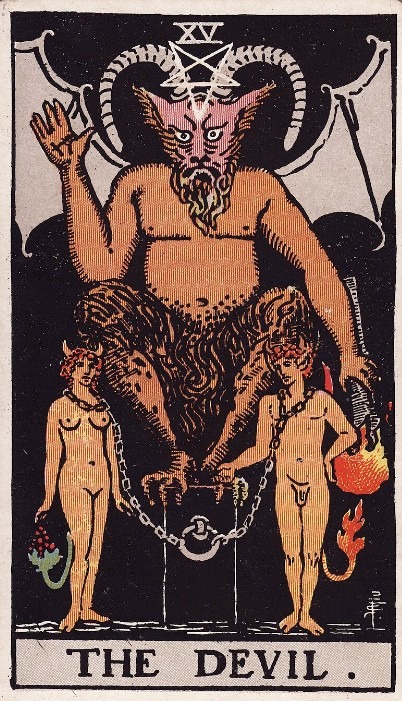
The devil begins the third and final line of cards. The fool has journeyed through the conscious and unconscious layers of his personality.
There are 7 cards left.
It’s time to delve deeper.
The fool will face his subconscious, the most hidden layer of his psyche.

The devil archetype appears across cultures and belief systems, both religious and occult.
The Waite/Coleman Smith devil has the look of Baphomet, a half-goat/satyr, half-man creature, often associated with the witch’s sabbat, horned god or as a deity for black magic and satanism.
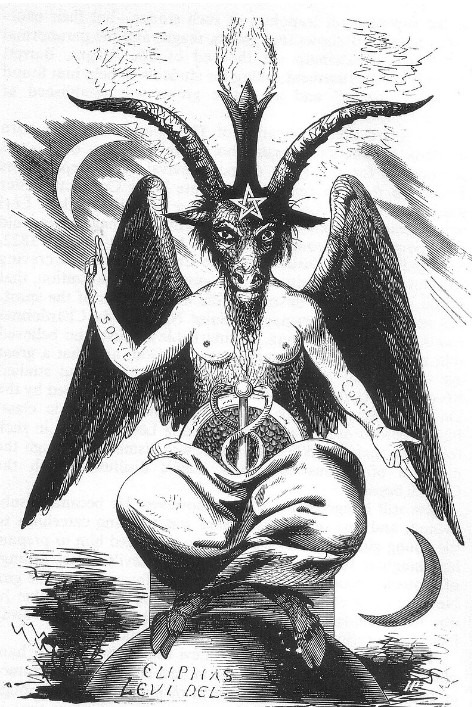
The devil in card 15 has the wings of a bat and claws for feet.
There’s a reverse pentacle between his horns.
He sits on a pillar with his right hand raised while the left points a lighted torch to the ground.
There are similarities with the magician, but the magician’s wand drew power from above. He was the conduit through which life energy flowed and became grounded.
The devil’s torch points to the earth. There’s nowhere for the energy to flow. It’s trapped within the material, physical world.
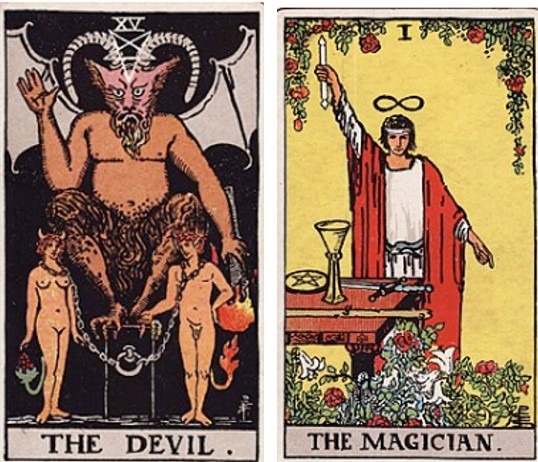
The outstretched fingers of the devil’s right hand form a V shape. Some say this comes from the Jewish priest or Kohan‘s blessing which forms the the hebrew letter shin for El Shaddai, the almighty (god) or divine power. All priests are mediators between above and below, like the magician.
This concept is reinforced with the glyph for planet saturn on the devil’s palm. It represents the boundary of time, a parody of the magician‘s mantra as above so below. In ancient Hebrew, saturn’s angel is Cassiel, a name for the temperance angel in card 14. Whereas temperance represented balance between inner and outer worlds, the ever present devil has the power to disrupt harmony.

A man and a woman, looking like Adam and Eve in the lovers card, appear chained to the pillar but the chains hang loosely around their necks, reminding the fool this is the card of illusion as well as desire.
They wear goat horns and tails, an indication of inner animal natures. The woman’s tail ends with fruit from the tree of knowledge while the man’s tail looks like the flames on the tree of life and the angel’s hair in the lovers.
We refer to flames of passion because sex is an energy. It can feel overwhelming and all consuming, but is rarely permanent.
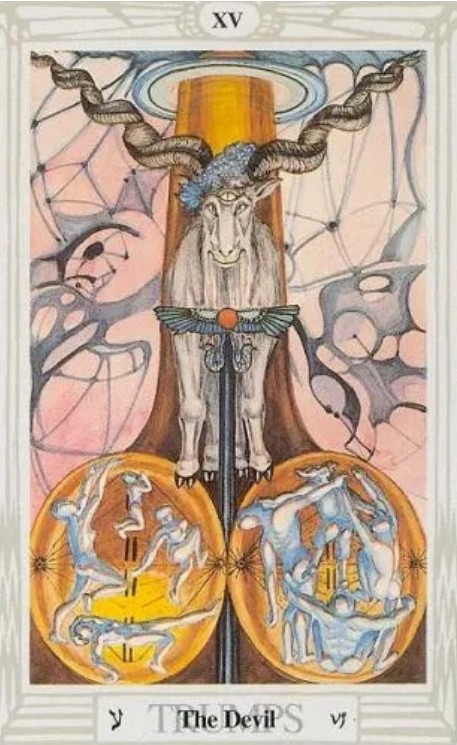
The western church required its priests to be celibate, their sexual energy reserved for chaneling toward god. In eastern traditions, sex and spirit are combined within tantric sex where desire can be harnessed and directed toward more spiritual forms of energy.
The devil is the card of desire.
It deals with the energy of life which can be manipulated and transformed, often releasing what’s been repressed.
We all have deeper, murkier sides and through this archetype, the transformation to pleasure can take a darker turn, as in addiction, self-harm or violence towards others.
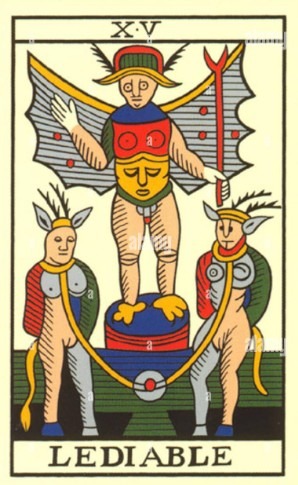
To feel desire is to witness control by the ego. Quashing the ego in the death card was not enough. It’s time for the fool to enter the ego’s world of temptation.
The devil card explains attraction. It reminds the fool how sometimes we want the very things which cause harm.
The roots of this paradox often lie in upbringing and the influences of early life. Psychologists have long recognised people choose partners who remind them of their parents, even when their home life was dysfunctional.
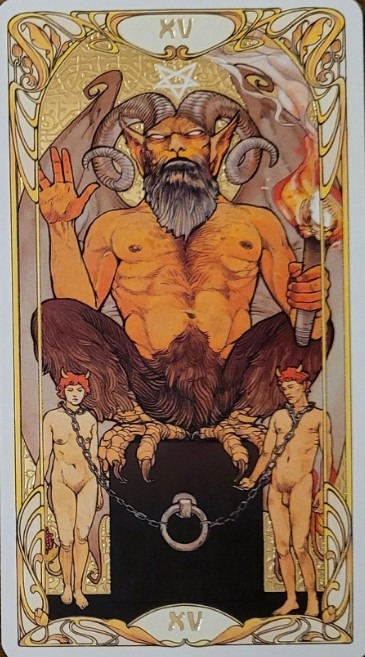
We take comfort from what feels familiar, regardless of the potential for abuse.
The man and woman are depicted as slaves to their desires, but the devil card represents both victim and perpetrator. Greed, lust, and perversion can be individual or encouraged by those already enslaved by avarice.
We make excuses for bad behaviour. Envy those who appear to have what we want. To be different from the crowd can become ‘demonised’ while the devil made me do it is a phrase often used to avoid accountability for action.
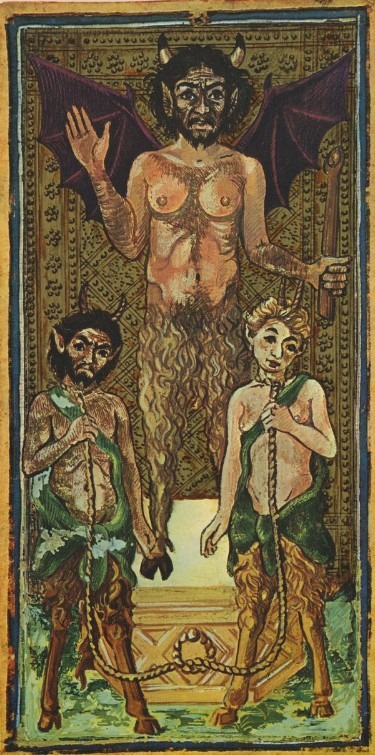
Not only can desire compel us to harm ourselves, some derive pleasure from causing harm to others. You can want to be loved or accepted so much, you’ll do anything, even when it’s fundamentally inhuman or destructive.
Others want to be unique. They construct identities through traits and attitudes considered negative and antithetical. Like attracts like, regardless of nature. There is power in numbers and the devil is the card of social unrest and disorder.
What lessons does this card have for the fool?
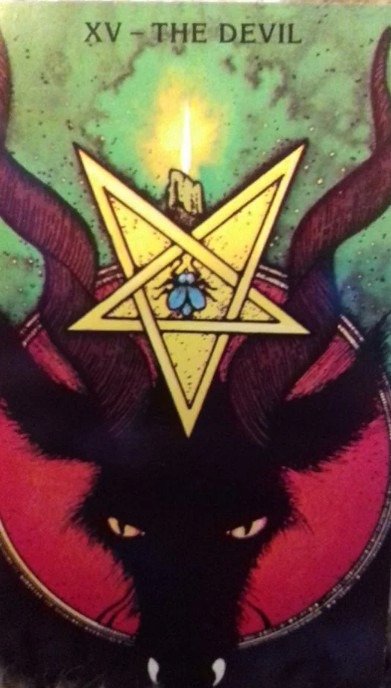
We all have a shadow side which contains repressed or rejected emotion. We store these in the deepest part of our psyche and try to forget their origins.
Repression of trauma can result in surface behaviours often negative to health. We might not understand or be able to explain the rationale, but continue to follow unhealthy lifestyles.
Activities can appear irrational and destructive but are mantained because they give relief, albeit temporarily.

Many people find ways to live without addressing the source of addictions or poor mental health, while others seek help. This will involve attempts to uncover the roots of negative behaviours by delving into the subconscious.
The fool might feel he has little choice over the darker aspects of his life, but card 15 shows the chains are not permanent. To know and understand the vagaries of the ego and its manipulative drivers of action, will help free the fool from its influence.
The devil might be seen as the source of temptation, but untimately the power to break addiction, and other unhealthy coping behaviours, remains down to individual choice and willpower.
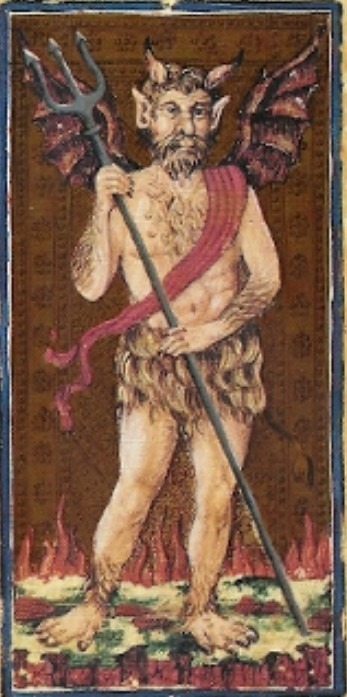
There are ways to release the devil’s chains.
It won’t be easy but can be done.
From this point on, the fool knows the devil inside him represents illusion.
The chains are not binding.
The next card the fool will meet on his walk through the tarot is the tower struck by lightening, the card of upheaval and potential destruction. Coming straight after the devil, what will the fool make of this?
Join us for the next step of his journey.
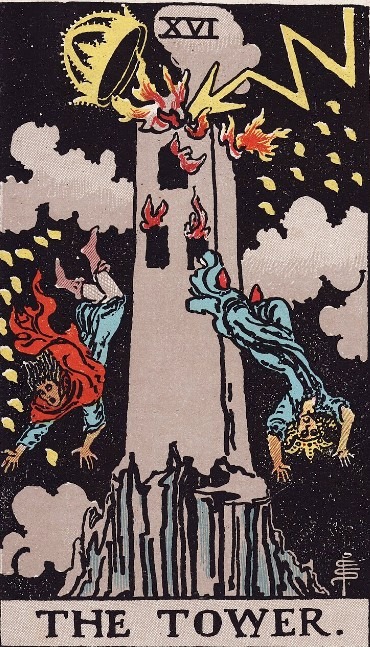
images my own, or copyright free from wikipedia commons and https://pixabay.com/